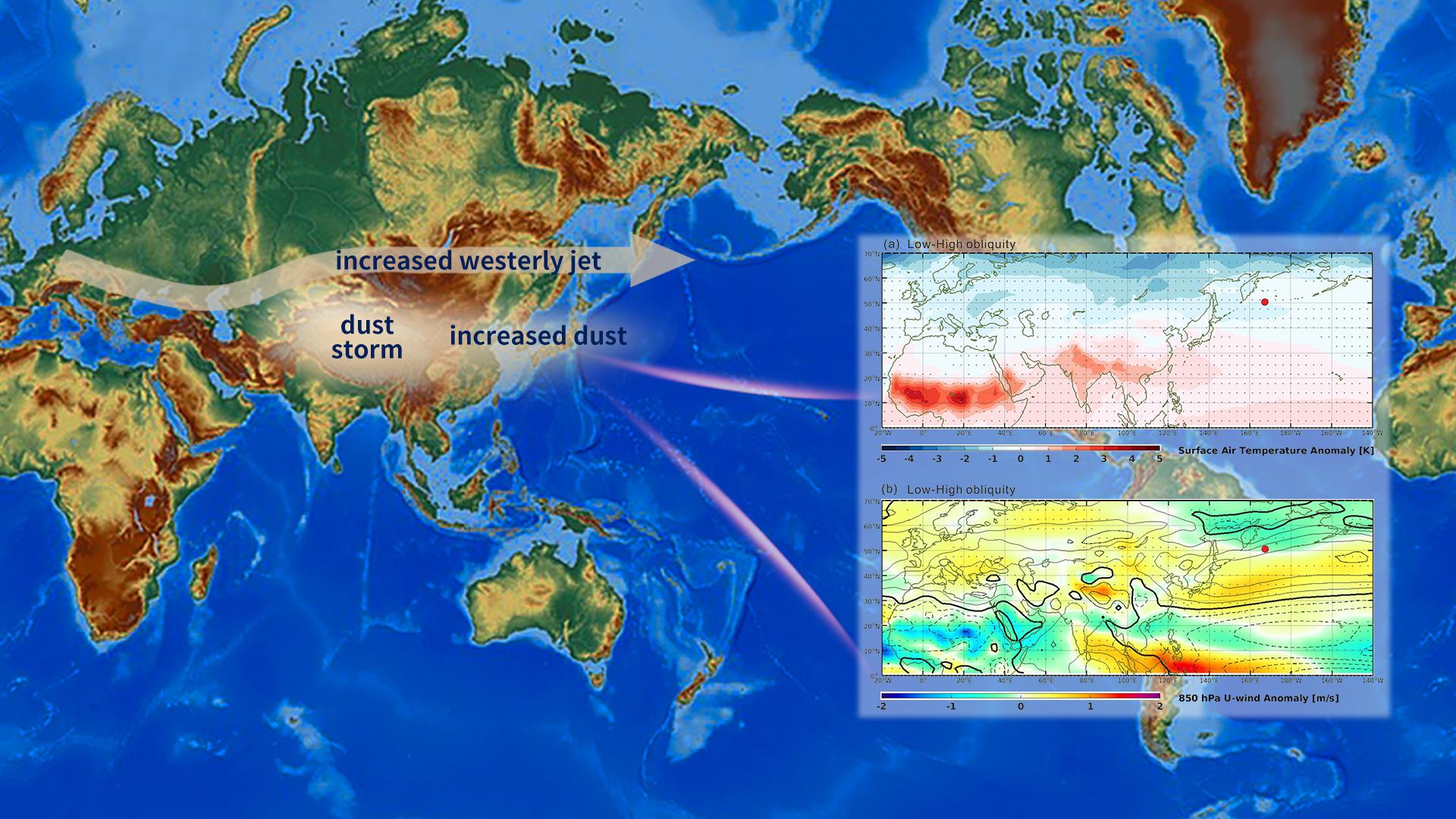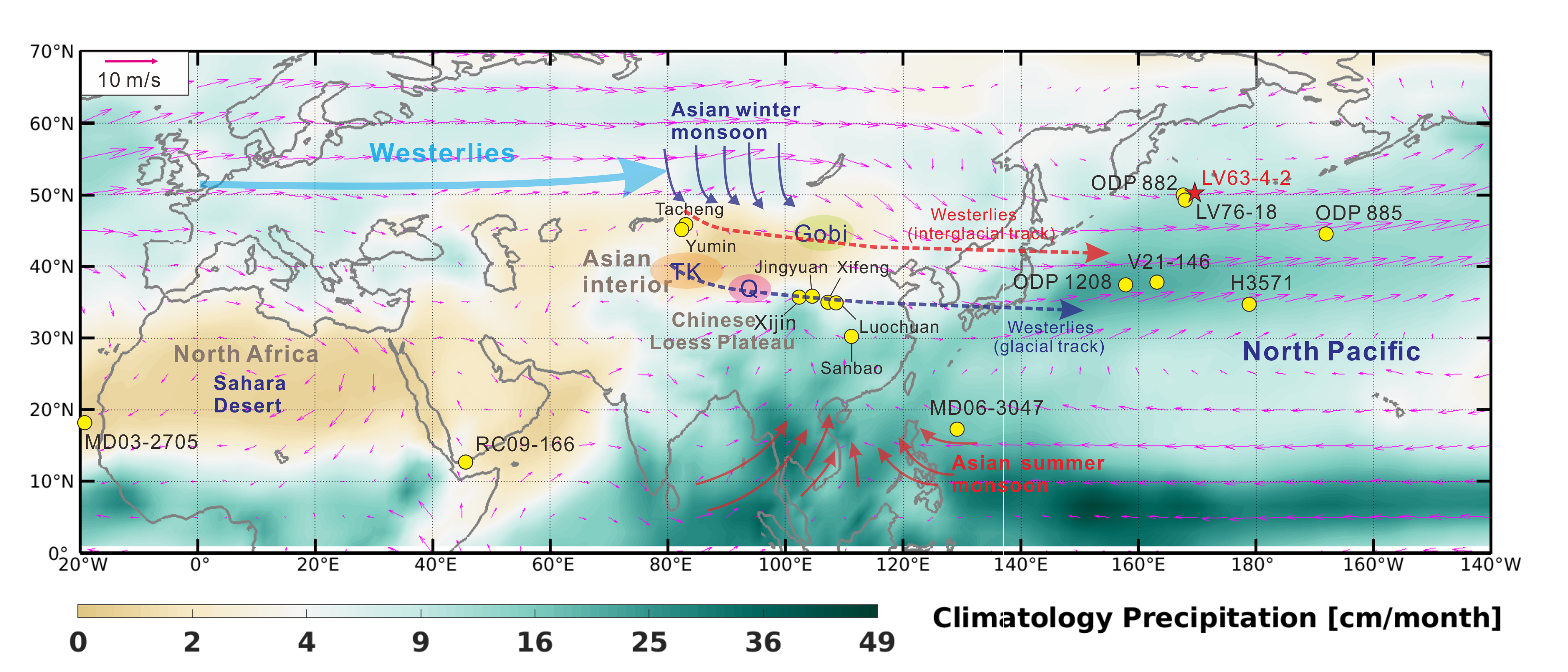The North Pacific Ocean is one of the largest and most productive marine ecosystems globally, supporting diverse marine life and fisheries of global significance. Understanding the dynamics of eolian dust in this region is crucial for assessing its impact on marine productivity, biodiversity, and ecosystem services. Furthermore, the North Pacific Ocean is susceptible to various anthropogenic and natural disturbances, including climate change, land-use changes, and extreme weather events, which may alter dust emissions, transport pathways, and deposition patterns. Therefore, continued research efforts are needed to monitor and assess the evolving dynamics of eolian dust in the North Pacific Ocean.

A team led by Chair Professor Qingsong Liu from the Center for Marine Magnetism (CM2) of the Department of Ocean Science and Engineering at the Southern University of Science and Technology (SUSTech) has recently conducted systematic studies on the flux of marine sedimentary dust in the North Pacific region and put forward new insights into the orbital-scale variation mechanisms of dust flux in the North Pacific.
Their findings, entitled “Orbital Controls on North Pacific Dust Flux During the Late Quaternary”, have been published in the authoritative journal Geophysical Research Letters.
The Earth system is a coupled system where energy transfer and material exchange occur among various layers. Dust, as an important medium, connects the lithosphere, atmosphere, and hydrosphere. Dust material not only indicates the sedimentary environment but also carries crucial environmental information, serving as a vital link in coupling marine-terrestrial processes.
East Asia, one of the world’s major dust source regions, witnesses large amounts of dust and wide dispersion. Approximately 600 Tg of dust is released into the atmosphere annually, with about 30% redeposited in desert areas, 20% transported to inland China, and the remaining 50% transported long distances to downstream areas such as the Pacific. North Pacific dust deposition is influenced by multiple factors, including dust release in the source regions, dust transport, and settling patterns. On one hand, temperature and humidity directly affect surface weathering, thus determining dust formation. On the other hand, the spatial-temporal evolution of the position and intensity of the westerlies in the Northern Hemisphere affects summer precipitation in East Asia and Central Asia, as well as the pathways and efficiency of dust transport.
Modern observations indicate that under the backdrop of global warming, the westerlies in the Northern Hemisphere are shifting northward. At orbital scales, North Pacific dust records exhibit strengthened ice ages and weakened interglacial periods. Previous studies mainly attributed this phenomenon to enhanced aridification in inland Asia. Past research predominantly utilized sediment from the southern part of the westerlies, lacking a comprehensive understanding of the entire process of dust release, transport, and settling in the North Pacific sedimentary areas, especially the dynamic processes of the westerlies at orbital time scales.
To elucidate the dynamics of dust at orbital scales in the North Pacific, the research team, in collaboration with various domestic and international institutions, including the First Institute of Oceanography of the Ministry of Natural Resources, the Southern Marine Science and Engineering Guangdong Laboratory (Zhuhai), KU Leuven in Belgium, and the University of London in the UK, reconstructed the changes in dust deposition in the subarctic Pacific over the past 190,000 years (Figure 1). Combining numerical simulation experiments under different Earth orbital configurations, the study made the following new discoveries:

Figure 1. Regional map showing annual mean precipitation (colour shading, see scale bar) and 850 hPa winds (arrows), based on the NCEP-DOE reanalysis (1979-2020).
Firstly, the researchers re-evaluated the reliability of environmental magnetic indicators in North Pacific dust research. Due to interference from volcanic island arcs, environmental magnetic indicators of North Pacific dust deposition are often affected. This study quantitatively evaluated the reliability of environmental magnetic indicators, such as fluxes of hematite and goethite, using geochemical trace elements, providing important constraints for the application of marine magnetism in dust deposition in subsequent studies.
Secondly, they analyzed precession control variations in humidity in dust source regions. The sedimentary record shows precession-dominated periodic changes in the ratio of hematite to goethite, indicating changes in weathering conditions driven by precession in dust source regions. Numerical simulations demonstrate that precession dominates precipitation in dust source regions such as Central Asia, thus determining weathering processes and dust formation.
Lastly, obliquity regulates the north-south displacement of the westerlies. Fluxes of hematite and goethite relative contents in sedimentary records exhibit slope-dominated variations. These variations show out-of-phase characteristics with records from nearby southern regions. Numerical simulations suggest that these out-of-phase fluctuations may be regulated by obliquity-induced changes in meridional temperature gradients and the north-south displacement of the westerlies.
Through the organic combination of environmental magnetism and paleoclimate models, this study reconstructed the response mechanism of North Pacific dust dynamics to high- and low-latitude climate systems, providing important paleoclimatic records and reference for a comprehensive understanding of Asian inland dust transport and its dynamic processes.
Associate Professor Yi Zhong from the Department of Ocean Science and Engineering at SUSTech is the first author of the paper. Chair Professor Qingsong Liu is the corresponding author, and Chief Researcher Hu Yang from the Southern Ocean Laboratory is the co-corresponding author. SUSTech is the first unit of the paper.
This research was supported by the National Natural Science Foundation of China (NSFC) and the Open Project of the State Key Laboratory of Marine Geology at Tongji University.
Paper link: https://doi.org/10.1029/2023GL106631
To read all stories about SUSTech science, subscribe to the monthly SUSTech Newsletter.
Proofread ByAdrian Cremin, Yingying XIA
Photo ByDepartment of Ocean Science and Engineering